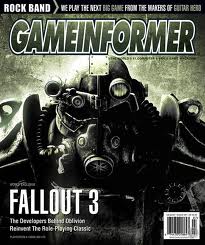
Bibliographic Information: McNamera, Andy. Game Informer. Sunrise Publications, August 1991-current. ISSN 1067-6392
Genre: Technology, Gaming
Reading Level: Ages 13+
Curriculum ties: Computers
Publisher: Sunrise Publications
Awards: None
Note: website: http://www.gameinformer.com
Reader’s Annotation: A bimonthly magazine for video game enthusiasts covering everything from games to systems.
Content: This bimonthly magazine features news, reviews and previews of games for the Nintendo Wii, PlayStation 3, Xbox 360, PC, Nintendo DS, PlayStation Portable, 3DS consoles.
The world’s largest-circulation video game magazine includes many other sections other than reviews of games. Some staples of this magazine include “Connect” which discusses the latest, cutting edge, news and technology from the gaming world; “Impulse” which serves as a guide for computer downloadable games; “Gear” where they highlight geeky gadgets designed to enhance your gaming experience; “Charts” which shows retail sales data for the editor’s top 10 games; and “Interviews” with influential people in the gaming business. Most of the pictures in the magazine are vivid snapshots within games which provide readers with a great sense of the games with just one look.
Critical Evaluation: One of the downsides to this magazine was the lack of age appropriateness ratings. Although the reviews gave very complete back stories and history of each game reviewed, there was little or no mention of the rating level. The only information that was constant was: style of game, publisher, developer, and release date. When including game reviews for younger children (like “Super Monkey Ball”; rated e for everyone) there should be some awareness to ratings for more mature games. The reviewing system is is as follows: a score of 1 is considered worse than terrible; 10 is a rare, “outstanding”, nearly perfect game; and 7 is “average”, a decently playable (but flawed) game. There have only bee 20 games that have received a perfect “10” score.
Booktalking Ideas: N/A
Challenge Issues/ Defense:
Challenge Issues: Violent images
Challenge defense ideas:
• Each video game has rating including the age appropriateness levels for each game.
• Refer to the Entertainment Software Rating Board (ESRB) for rating guidelines. See: http://www.esrb.org/index-js.jsp.
• Refer to Video Game, violence, sex and effects studies and statistics at: http://www.parentstv.org/ptc/videogames/reviews/studies.asp
Why was this book included?: Included as a representation of magazines tailored to male teens.
Editor Information: One of the original game journalists, Andy McNamara started his career in 1991 writing reviews of NHL Hockey and Sonic the Hedgehog for the Sega Genesis in the magazine’s premiere issue. Named editor-in-chief in 1994, McNamara turned the quarterly newsletter into the number one monthly video game publication in the world, with over 3.6 Million subscribers and counting. From the humble days of running the ASCII version of Star Trek on a workplace server to years of joyously exploring Atari 2600, ColecoVision, and Intellivision games during the golden age of video games, Andy immersed himself in pixilated adventures right up to the industry crash of 1983. Between ‘83 and ‘85 video games fell off the face of the Earth, but Andy rekindled his love of interactive entertainment when the Nintendo Entertainment System launched the modern era of video games with classics like The Legend of Zelda and Metroid. Andy still attributes Metroid as the reason he is involved with video games today. One of the longest standing editors and journalists in the industry, sharing his passion for games with gamers around the world is the reason Andy gets out of bed in the morning. Sure, it¹s around noon, but those are gamer hours.
(Editor biography obtained from Game informer website. Retrieved from: http://www.gameinformer.com/members/giandy/default.aspx).
